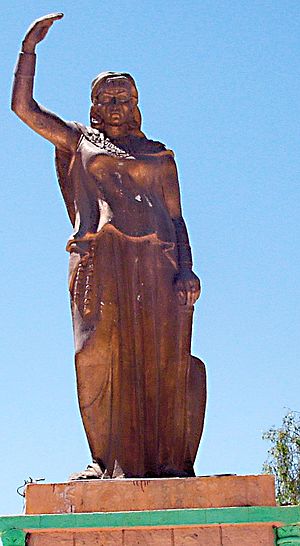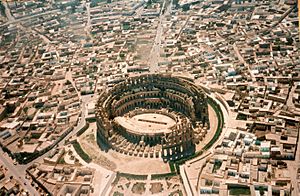Kahina facts for kids
Quick facts for kids Al-Kahina |
|
|---|---|
| Queen of the Aurès | |

Dihya memorial in Khenchela, Algeria
|
|
| Reign | Early seventh century |
| Predecessor | Kusaila |
| Died | 703 AD (in battle) Bir al-Kahina, Aurès |
| Father | Tabat |
Al-Kahina (which means "the diviner" in Arabic), also known as Dihya, was a powerful Berber queen. She was a religious and military leader who fought against the Muslim conquest of the Maghreb. This region was known as Numidia back then. She famously defeated the Umayyad forces in the Battle of Meskiana. After this victory, she became the ruler of the entire Maghreb region. However, she was later defeated in the Battle of Tabarka. Al-Kahina was born in the early 7th century AD and died around 703 AD in what is now Algeria.
Contents
Who was Al-Kahina?
Her real name had many variations, like Daya, Dehiya, Dihya, Dahya, or Damya. The name al-Kāhina was a nickname given to her by her Muslim opponents. It means "the priestess" or "soothsayer" because they believed she could see the future.
Dihya was born into the Jrāwa tribe, which was part of the Zenata people, in the early 7th century. She ruled a free Berber state for five years (from 695 to 700 AD). Her kingdom stretched from the Aurès Mountains to the oasis of Gadames. However, the Arab armies, led by Musa bin Nusayr, returned with a very strong force and defeated her. She fought bravely, even at the El Djem Roman amphitheater. She was eventually killed in battle near a well, which is still called Bir al Kahina in the Aurès region.
What was Al-Kahina's religion?
Some stories from the 1800s claimed she was Jewish or that her tribe followed the Jewish religion. However, many historians disagree with this idea.
According to an old historian named al-Mālikī, Al-Kahina carried an "idol" with her. Some historians think this idol was a Christian symbol, like an image of Jesus or the Virgin Mary. Others believe it was a symbol of a traditional Berber god. But the most likely idea is that Dihya was a Christian.
The idea that the Jarawa tribe was Jewish came from the medieval historian Ibn Khaldun. However, later historians like H.Z. Hirschberg have questioned this. They suggest that by Roman times, many Berber tribes had become Christian.
Historians have different ideas about where Al-Kahina lived or which tribe she belonged to. al-Mālikī said she lived in the Aurès Mountains. Later, at-Tijani said she belonged to the Lūwāta tribe. Finally, Ibn Khaldun wrote that she was from the Jarawa tribe.
Legends about Al-Kahina
Many legends surround Dihya. Some stories say she had very long hair or was very tall, which were traits often linked to sorcerers in old tales. She was also believed to have the gift of prophecy, meaning she could predict the future.
Another legend says she had three sons. Two were her own, and one was an Arab officer she had captured and adopted. This was also a common trait for witches in old stories. One famous legend claims that when she was young, she saved her people from a cruel ruler. She agreed to marry him and then killed him on their wedding night. Beyond these legends, not much is known about her personal life.
Al-Kahina's Conflicts and Battles
Dihya became the war leader of the Berber tribes in the 680s. She took over from Kusaila. She led the fight against the Arab Islamic armies of the Umayyad Dynasty.
Hasan ibn al-Nu'man led the Arab army from Egypt. He captured important Byzantine cities like Carthage. He then looked for another enemy to defeat. He was told that the most powerful ruler in North Africa was "the Queen of the Berbers," Dihyā. So, he marched his army into Numidia.
In 698, the armies met near Meskiana in Algeria. This battle is known as the Battle of Meskiana or the "battle of camels." Dihya won a great victory against Hasan. He was so badly defeated that he fled and hid in Cyrenaica (modern-day Libya) for several years.
Dihya knew that the enemy was very strong and would return. So, she decided to use a "scorched earth" tactic. This meant destroying everything that the Arab armies could use, like crops and towns. This plan didn't affect the mountain and desert tribes much. However, it made the people living in the oases (fertile areas in the desert) angry, and she lost their support. Instead of stopping the Arab armies, her desperate plan actually made her defeat happen faster.
Different Stories of Al-Kahina
The story of Al-Kahina is told in many ways by different cultures. Each story often gives a different or even opposite view of her. For example, some people use her story to promote ideas about women's rights. Others, especially Arabs, told her story in a way that made her seem like a sorcerer. This was an attempt to make her look bad. Her story has also been used to make colonialism seem positive, suggesting it freed Berbers from Arabs.
There is also a lesser-known story that Dihyā was interested in studying desert birds. Some old parchment fragments with bird paintings were found near where she died in Algeria. However, it's not certain if these fragments belonged to her.
Al-Kahina's Defeat and Death
Hasan eventually returned with his army. He was helped by an Arab officer named Khalid bin Yazid al-Qaysi, whom Dihya had captured and adopted. This officer shared information with Hasan. Hasan then defeated Dihya at the Battle of Tabarka. This battle took place near the borders of modern-day Tunisia and Algeria.
According to some stories, Dihya died fighting bravely, with her sword in hand. This final battle happened around 690 AD or 700 AD, with 703 CE being the most likely year. Some legends say she was 127 years old when she died, but this is likely just another myth. In any case, she was beheaded, and her head was sent to the Umayyad Caliph in Damascus as proof of her death.
Some historians say that Dihya's sons, Bagay and Khenchla, later converted to Islam and led the Berber army to Iberia (modern-day Spain and Portugal). However, another historian, Ibn al-Athīr, says they died with their mother.
Al-Kahina's Legacy
Al-Kahina has become a powerful symbol for women. She is also seen as a symbol of resistance against foreign occupation and, later, against male control. During the period of French Colonisation, Al-Kahina was an inspiration for women who fought the French. Women like Lalla Fatma N'Soumer and Lalla Khadija Bent Belkacem, who were known as warrior chiefs, looked up to Al-Kahina.
In the early 20th century, the French tried to make Algeria more "French" by connecting it to its Roman past. They saw themselves as similar to the Romans. But Algerian nationalists saw both Rome and France as colonial powers. For them, Al-Kahina was a hero who fought all invaders.
Today, Al-Kahina's image is often used by Berber activists. They use her to show that their people are strong and will not be conquered. Her face can be seen in graffiti and sculptures across Algeria. Artists often show her in ways that support the progressive ideas she represents. However, not everyone agrees with these ideals. One statue of Al-Kahina in Baghai was criticized by the government. The president of the Defense of the Arab Language said that Al-Kahina represented resistance to Islam, and therefore, should be condemned.
See also
 In Spanish: Kahina para niños
In Spanish: Kahina para niños


